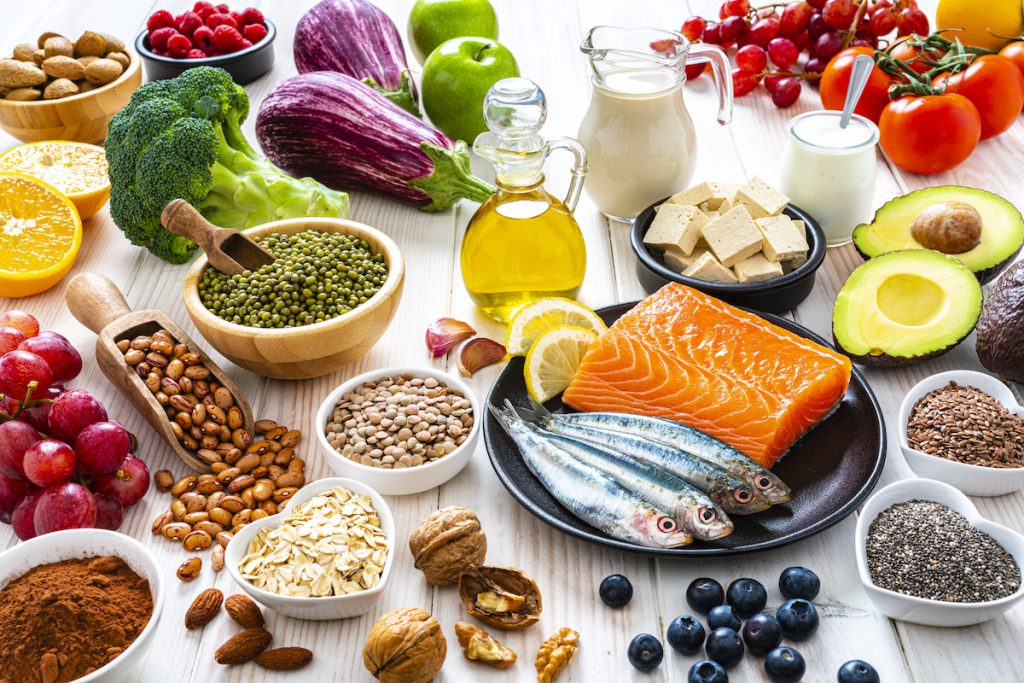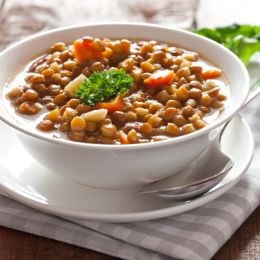Getting Started With the MIND Diet: A Guide for Beginners
The MIND diet is designed to reduce the risk of dementia and loss of brain function as you age. Find out if this eating style is the right fit for you.

Weight loss is the primary goal of most diets, but not everyone who follows a diet is looking to shed a few pounds. The word diet can refer to both a lower-calorie eating plan or an eating strategy designed to help you eat foods that improve your health. With the MIND diet, the main purpose is to improve your brain health and prevent the onset of dementia.
MIND stands for Mediterranean-DASH Intervention for Neurodegenerative Delay. This combination of two highly regarded diets has been linked to slower cognitive decline. Plus, it’s one of the easiest diets you can follow.
“Think of it as a healthy eating pattern designed for optimal brain health with aging,” says registered dietitian Katie Dodd, M.S., R.D.N., owner of the
We’ve answered all the questions you may have about the MIND diet, including what it is, its many benefits, and how to make it work for you.
Healthy eating and fitness go together! SilverSneakers classes and events are happening daily at participating gyms, online through SilverSneakers LIVE, and at community centers near you. Activate your free online account to get started.
What is the MIND diet?
Developed in 2015 at Rush University in Chicago, the MIND diet combines aspects of the two biggest health heavyweights among eating plans: the heart-healthy Mediterranean diet and the Dietary Approaches to Stop Hypertension (DASH) diet, which is specifically designed to help lower blood pressure.
The Mediterranean and DASH diets have both routinely earned top honors in U.S. News and World Report’s annual “Best Overall Diet” rankings. They analyze eating patterns and rank them for healthiness, safety, and ease. In 2023, the MIND diet was rated No. 4 among the best diets of 2023.
What are the brain benefits of the MIND diet?
Scientific evidence suggests the MIND diet is a recipe for better brain function in three important ways. It can:
Lower Your Dementia Risk
The MIND diet reduces chronic inflammation in the brain, which can harm cognitive health. Inflammation is your body’s natural response to injury and infection, but when it lasts for months or years, it can contribute to conditions like dementia, says Dodd.
“The foods recommended by the MIND diet have strong anti-inflammatory properties,” she says. This includes the omega-3 fats in salmon and tuna and the fiber in beans, fruits, vegetables, and whole grains. We’ll talk more about other MIND-friendly foods in a bit.
A study of more than 11,000 middle-aged adults over nine years in the American Journal of Clinical Nutrition study found that less than half a percent of the people who followed the MIND diet had developed dementia. What’s more, the MIND diet has been shown to ease symptoms and slow dementia progression in people who were already diagnosed with Alzheimer’s.
Recommended reading: 7 Ways to Eat Your Way to Less Inflammation
Improve Your Cognitive Function
A study from Rush University Medical Center found that the more closely older adults followed the MIND diet, the fewer symptoms they showed of cognitive decline. This is what’s known as cognitive resilience.
But even if you’re unable to follow this diet every day, there’s still benefit in giving it a try most of the time.
Prevent Brain Plaque
The MIND diet also benefits the brain by reducing potentially harmful beta-amyloid proteins. These are protein fragments that are found naturally in the body. However, they can accumulate and form plaques that build up in the brain, which disrupts communication between brain cells and eventually leads to brain-cell death.
The MIND diet’s high levels of nutrients and antioxidants, paired with lower levels of saturated and trans fats, may help prevent the formation of beta-amyloid plaques. This provides protection from brain decline and may lead to sharper thinking.
Recommended FREE SilverSneakers On-Demand Class: Everyday Exercise for Better Brain Health
What do you eat on the MIND diet?
The MIND diet is different from other popular eating plans because there’s no calorie counting and no food groups are eliminated. On the MIND diet, you simply eat more of the foods that the diet encourages and eat less of those that it recommends you limit, says Dodd.
“The key is to find foods you already enjoy to incorporate into a healthy eating pattern,” says Dodd. Here are the foods the MIND diet suggests that you make a regular part of your daily meals:
- Green, leafy vegetables, such as kale, spinach, and romaine. Aim for at least 6 servings a week.
- All other vegetables, such as carrots, bell peppers, and broccoli. Aim for at least 1 serving a day.
- Berries, such as strawberries, blueberries and blackberries. Aim for at least 2 servings a week.
- Nuts, such as almonds, pecans, and pistachios. Aim for at least 3 servings a week.
- Extra virgin olive oil. Make this your primary cooking oil.
- Whole grains, such as oatmeal, quinoa, brown rice, whole wheat pasta and 100% whole wheat bread. Aim for at least 3 servings a day.
- When possible, choose fatty fish such as salmon, sardines, trout, tuna, and mackerel for their high amounts of brain-benefiting omega-3 fatty acids. Aim for at least 1 serving a week.
- Beans. This category includes all beans, lentils, and soybeans. Aim for at least 4 servings a week.
- The best options are chicken or turkey breast or lean ground poultry. Fried chicken is not encouraged on the MIND diet. Aim to eat least 2 servings each week.
What foods should you limit on the MIND diet?
Like any diet, MIND is not just about what you can put in your mouth every day. It’s also important to know what you shouldn’t eat regularly. The MIND diet recommends limiting the foods below, since they can contain saturated fats or added sugars that can be detrimental to brain health when consumed in high quantities.
- Butter and margarine. No more than 1 tablespoon daily.
- No more than 1 one ounce serving a week.
- Red meat. This includes all beef, pork, lamb, and products made from these meats. No more than 4 servings a week.
- Fried food. No more than 1 serving a week.
- Pastries and sweets. This includes most highly processed sugary snack foods and desserts. No more than 5 servings a week.
Remember, the key here is to limit these foods, not eliminate them completely. “There is still room for these items within the MIND diet, but they should be occasional inclusions,” says Dodd.
Recommended reading: 8 Delicious Ways to Eat Your Way to Better Brain Health
Are there any other benefits of following the MIND diet?
Absolutely. Although the chief purpose of the MIND diet is to improve brain health, it may also improve heart health and offer protection against diabetes and certain cancers. That’s because the MIND diet includes components of the Mediterranean and DASH diets, which both have been proven to lower the risk of these conditions.
Subscribe to our newsletter
It's quick and easy. You could be one of the 13 million people who are eligible.
Already a member? Click to discover our 15,000+ participating locations.
Follow Us
In a 12-year study of 882 older adults, British researchers found that following the MIND diet closely m
Remember the U.S. News and World Report’s annual diet rankings mentioned above? In 2023, the MIND diet also ranked high in the categories for “Best Plant-Based” (No. 3) and “Best for Bone and Joint Health” (No. 4). And it came in No. 5 for “Best Heart-Healthy”, “Best Diabetes”, and “Best for Healthy Eating” categories.
Are there any risks or downsides to the MIND diet?
Not really. Nutritionally speaking, there aren’t any health risks associated with the MIND diet, and because this diet has a lot of variety, it’s easy to stick with.
Eating this way will require some careful meal planning, however. You’ll need to shop for ingredients for meals and snacks that make use of MIND-diet foods. This may be challenging for those who do not cook. Those who eat out frequently should review restaurant menus before going to the restaurant to make sure they offer options that work within this eating plan.
Those with chewing or swallowing issues may have difficulties eating some of the encouraged foods. “Some individuals with certain medical conditions or on certain medications may need to make modifications to the MIND diet to best fit their individual needs,” says Dodd. Talk to your doctor or a nutritionist if this is an issue for you.
And before you start worrying that your grocery bill will skyrocket, it doesn’t have to. Pouches and cans of salmon and tuna are wise choices, as are frozen vegetables and berries. Just be mindful that you’re buying items that don’t contain sauces and sweeteners.
Recommended reading: Canned Foods Are Convenient, but Are They Good for You?
Make Every Workout Better—with Your Mind
What else can I do to protect my brain health?
Beyond following a healthy eating plan, it’s never hurts to incorporate other brain-boosting activities into your lifestyle.
- Get plenty of exercise. Physical activity builds up our brain muscle too. Most guidelines call for at least 150 minutes (about 2 and a half hours) a week of moderate-intensity exercise. They also recommend muscle-strengthening exercises at least twice a week on non-consecutive days.
- Be social. According to the Centers for Disease Control and Prevention, loneliness is associated with a 32% increased risk of stroke and a 50% increased risk of developing dementia. It’s important to spend time with loved ones, whether it’s a weekly lunch date, a Zoom or FaceTime chat, or a phone conversation.
- Stay mentally stimulated. Research clearly shows that our brain gets sharper the more you use it. Challenge your mind by playing a word game, playing a musical instrument, studying a new language, or teaching yourself a new hobby.
- Schedule routine health checkups. Seeing your doctor regularly gives you a chance to discuss any concerns related to your memory and thinking skills. Your doctor may recommend a cognitive assessment, which can be done right in the office.
For more information on taking care of your brain healthy as you age, read How to Keep Your Brain Healthy: The SilverSneakers Guide.
See our sources:
Alzheimer’s disease facts: Alzheimer’s Association
How berries affect brain health: Scientific Reports
MIND diet, dementia risk and brain structure: American Journal of Clinical Nutrition
Link between MIND diet and cognitive resilience: Journal of Alzheimer’s Disease
How MIND diet affects mortality risk: Public Health Nutrition
U.S. Physical Activity Guidelines: U.S. Department of Health & Human Services
How loneliness affects brain health: Centers for Disease Control and Prevention
Check Your SilverSneakers Eligibility Instantly
SilverSneakers members can go to thousands of nationwide gyms and fitness locations, plus take SilverSneakers LIVE online classes that are designed for all fitness levels and abilities. If you have a Medicare Advantage plan, it may include SilverSneakers — at no additional cost. Check your eligibility instantly here.
Already a member? Get your SilverSneakers member ID and exclusive fitness and wellness content by activating your online account here.
Not eligible for SilverSneakers? You can still get 200+ free SilverSneakers On-Demand videos and stay in touch with us by creating your online account.





